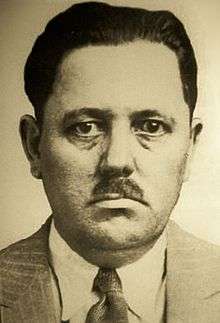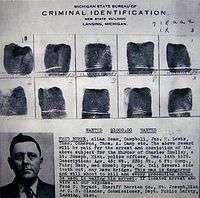Fred Burke
| Fred Burke | |
|---|---|
 "Fred "Killer" Burke | |
| Born |
Thomas A. Camp May 29, 1893 Mapleton, Kansas, United States |
| Died |
July 10, 1940 (aged 47) Marquette State Prison, Marquette Michigan, United States |
| Other names | Killer |
| Occupation | Gangster, contract killer, armed robber |
| Criminal charge |
|
| Criminal penalty | Life sentence |
| Criminal status | Deceased |
| Spouse(s) | Bonnie (Porter) Burke |
"Fred "Killer" Burke (May 29, 1893 – July 10, 1940) was a Midwestern armed robber and contract killer responsible for many crimes during the Prohibition era. He is considered a prime suspect in the infamous St. Valentine's Day Massacre of 1929.
Early life
Fred R. Burke was born Thomas A. Camp, one of eight children of Mr. and Mrs. Wall Camp of Mapleton, Kansas. Teachers considered him as having above-average intelligence and he was a regular Sunday School attendee.[1] Burke's first brush with the law came while still a teenager. At seventeen he was involved in a land-fraud scheme with a traveling salesman. He fled the area to avoid prosecution and became involved with criminal enterprises around Kansas City, Missouri. It was during this time he is believed to have changed his name from Thomas Camp to Fred Burke.[2]
Criminal career
Fred Burke had migrated to St. Louis, Missouri by 1915 where he became a member of the city's top gang, Egan's Rats. In these early years his criminal activity was mostly devoid of the violence that so permeated his life in the 1920s and early 1930s. Burke, described as tall, well-built, and honest-looking, acted as a "front man" for the Egan gang in various forgery and fraud schemes.[3] In 1917 Fred Burke chose to enlist in the U.S. Army after being indicted in St. Louis for forgery. America had recently entered World War I, and Burke served as a tank sergeant in France. After his return from overseas duty and discharge, Fred Burke was soon arrested for land fraud in Michigan and spent a year imprisoned there, followed by another year in the Missouri state prison for the pre-war St. Louis charges.
By 1922, Burke was back with Egan's Rats and working with a crew of three fellow war vets in various robberies around the Gateway City, including a "take" of $80,000 dollars from a St. Louis distillery. However, things began to change in 1924 as the top bosses of the Egan gang were jailed. Fred Burke returned to Michigan with his crew where they became associates of the notorious Detroit Purple Gang. Burke, Gus Winkler and the other Egan's Rats refugees, working on behalf of the Purple Gang, were the prime suspects in the March 1927 Milaflores Massacre.[4] However just a few months later a falling out with the Purple Gang led Burke and his associates to relocate to Chicago. Their reputation preceding them, Burke's crew were eagerly welcomed by Al Capone, who referred to them as his "American Boys". Working out of Chicago, Fred Burke and his cohorts were involved in a series of murders and armed robberies as far east at Brooklyn, New York and Paterson, New Jersey and as far south as Louisville, Kentucky. Among them was the murder of Toledo, Ohio police officer George Zientara[5] following a bank robbery in 1928. It would not be Burke's last "cop killing."
St. Valentines Day Massacre
In 1928 and early 1929 Al Capone had a problem in the name of Bugs Moran and his Irish gang from Chicago's Northside. Fred Burke and his crew of killers were his problem-solver. Five members and two associates of the Moran gang were lured to a garage on Clark street in Chicago. Burke and company burst into the meeting, some dressed as police, and executed the Moran faction. The shocking event received international press attention and within a few weeks Fred Burke was named by Chicago police as a principal suspect in the murders.[6] Witnesses placed Burke near the scene and guns seized from his home later in 1929 were matched to bullets from the crime. Years later, in 1935, Byron Bolton, a captured member of the Barker Gang, gave a detailed statement to the FBI implicating Fred Burke, members of his crew, and other Capone gang members as being responsible.[7]
Downfall and death

Following the St. Valentine's Day massacre, Fred Burke continued his pattern of armed robberies and the occasional murder. The beginning of the end happened however in December 1929. An intoxicated and paranoid Burke, using the alias Fred Dane, was involved in a minor traffic accident in St. Joseph, Michigan. When Patrolman Charles Skalay (sometimes mistakenly identified as Skelly)(Charles, and several other family members, actually changed the spelling of his last name to Skelly) arrived at the wreck scene he was shot and killed by Burke.[8] Now named America's most wanted man, Fred Burke fled to rural northern Missouri to "lay low". A Michigan police bulletin offering a $1,000 reward said in underscored type: This man is dangerous and will shoot to kill and every precaution should be used in making his arrest. Among the aliases listed for Burke were Fred Dean, Fred Campbell, and Theodore Cameron.[9] Burke took on yet another alias back in Missouri, that of Richard F. White. In 1930 Burke married a woman from Sullivan County, Missouri, Bonnie Porter, and took up residence near Green City in Sullivan County. However, even while hiding from the law Burke could not give up his criminal ways. According to an eyewitness account in an article in The Chariton Collector magazine, Burke resided in a Kirksville, Missouri hotel, the Traveler's Hotel, for a few days prior to a local bank robbery.[10] Later his wife would claim no knowledge of Burke's real identity or his criminal past and thought her husband was just a businessman who travelled a lot.
The long arm of the law finally caught Fred Burke on March 26, 1931 in a most unlikely manner. An amateur detective in the Green City area had read of Burke and seen his picture in True Detective magazine,[11] recognized him as Richard White, and notified authorities. Fred Burke was captured at the home of his father-in-law, without a single gunshot being fired. Returned to Michigan, Burke was convicted of Officer Skalay's murder and given a life sentence at Marquette State Prison. Having been in failing health with diabetes and heart disease for several years, Fred Burke died of a massive heart attack while behind bars on July 10, 1940.
Documentary video
- Fred Lowry (Director), How Burke Was Captured, 1931 via crimedocumentary.com / runtime: 15 minutes.
References
- ↑ "Fred "Killer" Burke". My Al Capone Museum. 2007. Retrieved 2011-07-10.
- ↑ "Fred Killer Burke". The Outlaw Journals. 2006. Retrieved 2011-07-10.
- ↑ "Fred Killer Burke". The Outlaw Journals. 2006. Retrieved 2011-07-10.
- ↑ Egan's Rats: The Untold Story of the Gang that ruled Prohibition-era St. Louis by Daniel Waugh, Nashville: Cumberland House, 2007.
- ↑ George Zientara
- ↑ "Fred Killer Burke". The Outlaw Journals. 2006. Retrieved 2011-07-10.
- ↑ The St. Valentine's Day Massacre: The Untold Story Of The Bloodbath That Brought Down Al Capone by William Helmer and Arthur J. Bilek. Nashville: Cumberland House, 2004.
- ↑ "Fred "Killer" Burke". My Al Capone Museum. 2007. Retrieved 2011-07-10.
- ↑ "Fred Burke Jail Ledger". Berrien County (Michigan) Sheriff's Department. 2009. Retrieved 2011-07-11.
- ↑ "Gangster Connections" (PDF). The Chariton Collector. Spring 1981. Retrieved 2011-07-11.
- ↑ Renard, Ray as told to Frank Calhoun. "Fred Burke, Gangster—As I Knew Him,"True Detective Mysteries,(October 1930) pp. 12, 14, 16, 132-134.
Further reading
- Waugh, Daniel. Egan's Rats: The Untold Story of the Gang that ruled Prohibition-era St. Louis Nashville: Cumberland House, 2007. ISBN 1581825757
- Helmer, William and Arthur J. Bilek. The St. Valentine's Day Massacre: The Untold Story Of The Bloodbath That Brought Down Al Capone Nashville: Cumberland House, 2004. ISBN 978-1581825497
External links
- "Fred Burke". Find a Grave. Retrieved 2009-02-21.
- Fred "Killer" Burke